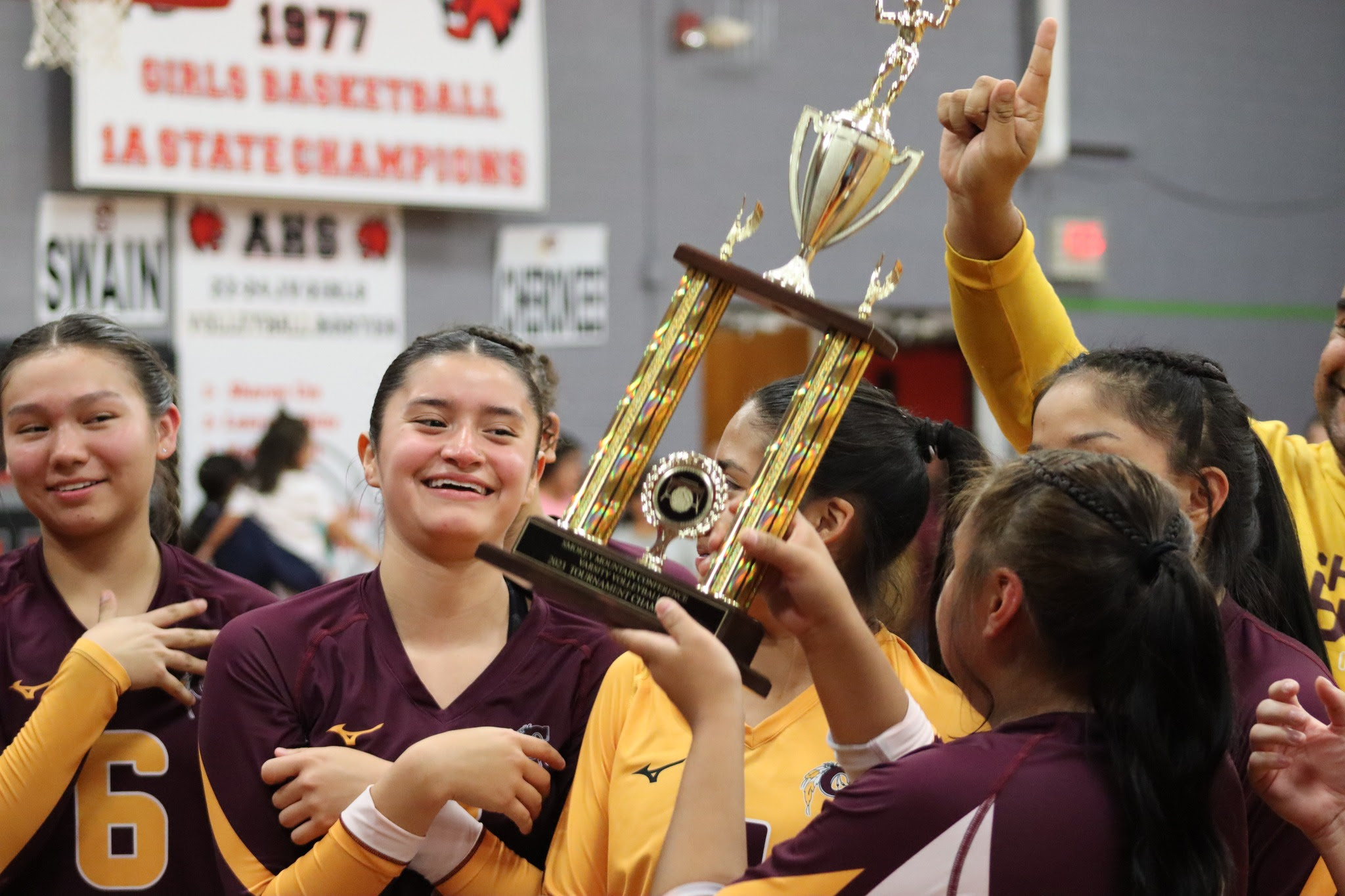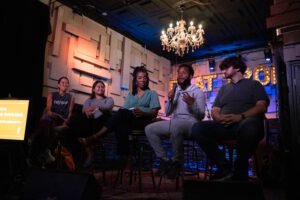By Catherine Komp,
NC Local Newsletter Editor
Brooklyn Brown has early memories of being featured in the Cherokee One Feather for her birthday or making the honor roll. Her grandma was an avid reader of the weekly paper covering the Eastern Band of Cherokee Indians (EBCI) and would submit photos for the “Celebrations” section.
“I think that’s something we do really well. We allow our community to have a voice with the One Feather and they feel like it’s theirs too,” said Brown.
Brown is reporter for the Cherokee One Feather, a path she shaped by first studying journalism at UNC-Chapel Hill and writing for the Durham Voice and later getting a Master of Arts in History with a focus in Cherokee Studies at Western Carolina University. Her first assignment after joining the staff last month was covering the 111th Annual Cherokee Indian Fair.
“It was really a trial by fire. I jumped right in,” said Brown.
From pageants to stickball to Elder’s Day, Brown and Assistant Editor Scott McKie captured hundreds of moments from the fair. For Brown, it was the first time photography was a central component of her job.
“A lot of what I studied at Western was old pictures of the fair or community events. And so I’m like, I’m actually documenting history with these pictures. Being at the fair, taking pictures of stickball is history documentation,” said Brown. “I’m really proud of that. And it’s sort of an immediate, lasting impact of my first week at the One Feather.”

Evolution of the One Feather
The Cherokee One Feather, ᏣᎳᎩ ᏐᏉ ᎤᎩᏓᏟ in Cherokee Syllabary or tsa-la-gi so-qou ugi-dah-li phonetically, covers news, sports, arts and culture, community views and tribal government on the Qualla Boundary in Western North Carolina.
Editor Robert Jumper says the One Feather started publishing in the mid 1960s and for many decades was more of a newsletter of the tribal government. When he joined staff about 11 years ago, there was momentum to establish more independence and make the One Feather “a community newspaper that belonged to the community, not the government.”
“There was actually a Free Press Act put in place in Cherokee code, but it really didn’t have any strength. It didn’t have any teeth. There was really no oversight or security to protect the One Feather from [government] influence,” said Jumper.
Jumper worked with Scott McKie, who joined staff in 1998, on a series of measures to strengthen the Free Press Act, including giving the editorial board more power and protecting the staff from political interference.
“The most recent legislation that we put in basically says that an editor cannot be fired without the consent of both the chief, the vice chief, and two thirds of the editorial board. So that basically puts insulation between the One Feather and the government,” said Jumper. “Which gives the editor a really broad ability to give the people what they need — which is better access to the information.”
All of the staff are on the editorial board, a draw for both Brooklyn Brown and Ad Sales Coordinator Dawn Arneach, who is the board’s vice chair and often fills in covering events.
“I like being part of the decision making and helping guide the future of the paper,” said Arneach. “Whereas before, it was blindly done without a direction. Now that there’s a board and ideas, and [efforts to make] sure we stay within the realms of journalism, it makes for a smoother working environment.
Jumper says they continue to work on strengthening the One Feather’s independence and have put forward new legislation scheduled for discussion in December that would replace government members of the editorial board with appointments of community members.

Super-serving the audience
The award-winning Cherokee One Feather does a lot with its small team, currently four staff members, with a subscription clerk position open. The weekly print paper, with a circulation of about 2,000, is about 45 pages long. Their annual budget is about $400,000; about 70% of this funding comes from the EBCI, another 30% from advertising.
Taking a page from the Pivot Fund’s Tracie Powell, who is asking BIPOC publishers how they’d spend some of Press Forward’s $500 million in funding for local news, I posed the same question to the Cherokee One Feather staff. Dawn Arneach would hire a full-time tribal linguist. Brookly Brown would like to have more reporters and a photojournalist on staff. Robert Jumper says they could do a lot with a full-time IT staffer to help automate things like classifieds and subscriptions.
“Those kinds of things would be immensely helpful,” said Jumper. “Having a linguist would be fantastic and also having reporters so that I could take the load off of [Scott and Brooklyn] would be super.”
Even with their limited resources, the Cherokee One Feather continues to innovate. They’re seeing digital growth with about 70,000 followers on Facebook and nearly 7,000 on Instagram. Jumper says their recent Facebook reach has hovered around one million for the last month.
 “The great thing about having a really good reach and good Facebook following, is that we get to hear from the community probably more than anybody else on the [Qualla] Boundary. And because of that we can prioritize pretty good what our community wants to hear about,” said Jumper.
“The great thing about having a really good reach and good Facebook following, is that we get to hear from the community probably more than anybody else on the [Qualla] Boundary. And because of that we can prioritize pretty good what our community wants to hear about,” said Jumper.
You can see that community influence on coverage of the crowning of Little Miss, Junior Miss, Teen Miss and Miss Cherokee; updates on fund allocations for the annual Scare-okee event and publication of every entry in the annual Monster Photo Contest; and the profile of an EBCI member’s journey in completing a 100-mile race. The One Feather provides plenty of hard news as well, covering the school board, the expansion of housing and senior care facilities, the launch of public health vending machines, and in-depth coverage and candidate forums for this year’s tribal elections.
Brooklyn Brown is working on expanding the One Feather’s coverage of Missing and Murdered Indigenous Women (MMIW). In addition to continuing their coverage of the local chapter of MMIW and providing weekly informational graphics, Brown is planning an ongoing feature series.
“This month will be my first MMIW monthly article. And what I’m envisioning for those is a case study. Because we have 35 cases, and so I want to do a feature on each of those cases as much as possible,” said Brown.
Brown’s research on MMIW led to her second op-ed for the One Feather, which explored the issue of human trafficking and whether it’s happening locally. Jumper says they are hoping to convene a town hall on the topic to bring together the community and tribal government.
“There is such a gap between what is said and what we see when we go checking things like the arrest reports and the court dockets,” said Jumper. “There’s quite a disparity in what information is provided that way versus what you hear from the community about human trafficking.
Jumper says another big topic for 2024 is economic issues for the EBCI, including how the tribe will move forward with cannabis operations after voters approved a referendum legalizing adult use of marijuana
“Our new chief is very cautious and he’s very organized so I’m sure he’s going through each one of our revenue streams and identifying what he needs to do to make things work better,” said Jumper. “Those [revenue streams] will be very significant to our tribe in the amount of services provided to our people. That’s going to be a huge, huge thing this year.”
 While many local news organizations are working toward developing audience strategies, the Cherokee One Feather has long had a solid understanding of who it serves and their community’s information needs. Readers can rely on the One Feather for live coverage of sports and to see professional photos of their kids and grandkids competing in stickball, volleyball and cross country. They get the latest on turkey give-aways, Christmas parade rules (including this year’s stipulation of only one Santa), community meetings and fundraisers. Each week, they publish a short profile of Beloved Women in the community and a Cherokee Word of the Week. Community pets get their own regular feature too.
While many local news organizations are working toward developing audience strategies, the Cherokee One Feather has long had a solid understanding of who it serves and their community’s information needs. Readers can rely on the One Feather for live coverage of sports and to see professional photos of their kids and grandkids competing in stickball, volleyball and cross country. They get the latest on turkey give-aways, Christmas parade rules (including this year’s stipulation of only one Santa), community meetings and fundraisers. Each week, they publish a short profile of Beloved Women in the community and a Cherokee Word of the Week. Community pets get their own regular feature too.
“We never forget who we report to. We asked and basically made the demand that we be a community paper,” said Jumper. “We know what side our bread is buttered on. If we didn’t cover those kinds of things, the community would not be in love with the One Feather.”
Find the latest issue of the Cherokee One Feather here and follow them on Instagram and Facebook.




